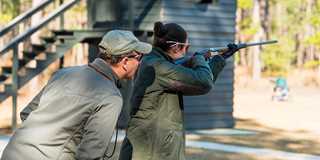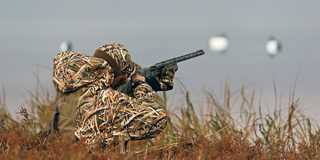Don't Miss!
To correct the most common shotgunning mistakes, learn to stop thinking and let your eyes and hands take over
To correct the most common shotgunning mistakes, learn to stop thinking and let your eyes and hands take over
We have all made that pure-reflex shot when a duck takes us by surprise. It might be a wood duck coming from behind the blind first thing in the morning, a bluebill skirting the spread, or a teal buzzing the decoys out of nowhere. Because we are surprised, we raise the gun and fire without taking the time to think about it. And then were equally surprised when the bird folds up, perfectly hit.
The explanation for those shots is simple: In the heat of the moment, we forget to make any mistakes. Left alone, our eyes and hands can put a shotgun muzzle in the right place to hit a moving target with uncanny precision. Most wingshooting mistakes are the ones that sabotage our eye-hand coordination. Here are 11 common mistakes, organized roughly from the beginning of the shot to the end, and how to fix them.

Photo DAYSAFIELDPHOTOGRAPHY.COM
Most shooters rush their mount, slamming the gun to their shoulder, then dropping their head and fitting it to the stock before chasing the target with the muzzle. Its an inefficient move that costs you time and negates your natural pointing ability. You can get on target faster and take better advantage of your eye-hand coordination when you learn to bring the gun to your face first. Start moving the muzzle to the target as you lift the gun. Pull the trigger as soon as the butt meets your shoulder, and the gun will shoot where youre looking. Be smooth, not fast, and let your front hand do most of the work. Practice this at home using an unloaded gun with a laser or a flashlight in the muzzle to be sure youre not over-controlling with your trigger hand, which will cause the muzzle to dip.

Photo JEFFMOOREIMAGES.NET
Too many of us self-taught shooters learn to aim BB guns and .22s before we ever shoot at flying targets, and we carry over the aiming habit when we learn to shoot shotguns. Think about how quickly and easily you can point your finger at any object. As soon as you start trying to line up the barrel, bead, and target, you interfere with that natural ability. Aiming a shotgun leads to slowed and stopped swings. Its also extremely difficult to lead targets if youre aiming at them down the gun barrel. If the gun has to be ahead of the bird, there is no way you can look down the barrel and at the bird at the same time. Freeing your eyes from the gun requires practice on the skeet field or sporting clays course. Once you can focus your eyes on the bird and let the barrel find the correct lead in your secondary vision, leading targets becomes much easier.
When a group of birds comes in and you dont focus on a single bird when you shoot, its called flock shooting. Anyone whos ever done it knows the resultyou dont hit a duck; you hit the space between the ducks. Picking one bird out of the bunch is a good start. Dialing your focus down to the birds head is even better. In wingshooting, the quality of the visual input affects the quality of the shooting output. The more precise the information your eyes give your hands, the better the shot will be. The rifle shooters mantra aim small, miss small applies to shotguns, even though shotguns arent aimed. Clay target shooters know this, and they will focus on the rings on the clay, or the front edge. Of course, theres a lot more to look at on a duck or a goose than there is on an orange disk. Lock your eyes onto the head, the eye, or the bill and youll place your patterns consistently on the front end of the bird.
Telling yourself not to miss makes you miss. Thinking about how much you need a bird to finish a limit makes you miss. Fear, hope, doubt, and anxiety all make shooters and other athletes too careful. Golfers leave putts short and basketball players hit the front of the rim with free throws in pressure situations because they hold back out of fear of missing. The same thing happens to shotgunners, except we shoot extra carefully and check the gun to be sure its perfect because we dont want to miss. Do that and youll stop the gun and shoot behind. Keep your thinking positive. Shoot without fear of missing and youll miss less.
A lot of people shoot with one eye closed, and some shoot very well that way. But our eyes are designed to work together. Not only does shooting with one eye closed deprive you of depth perception and half your peripheral vision, it makes any target look smaller and faster. Shooting with both eyes open takes time to learn, but once you do, its much easier than shooting one-eyed. Start by shooting at stationary objects with both eyes open, then move on to going-away or incoming clays. The more you can focus your eyes on the target, not the gun, the easier two-eyed shooting becomes.

Photo Michael Peters
The bead on your shotgun is there as a reference point, not a sight. The main cause of stopping the gun is looking at the bead. Learn to trust your eyes and hands to put the shot on target, and resist the temptation to draw a bead on it. One practice drill to try is shooting a target and paying attention to how many pieces it breaks into and which way the biggest piece flies. Concentrating on actually seeing the break keeps your eyes on the bird and away from the bead. Theres nothing wrong with a bright fiber-optic bead . . . if you dont look at it. A bead that keeps you aware of your gun barrel in your secondary vision is doing what a bead is supposed to do. If fiber optics work for you, great. But if a bright bead, or any bead, distracts you, follow the lead of sporting clays shooters, many of whom remove their front bead and either shoot without a bead or install a smaller middle bead.

Photo DOUGSTEINKE.COM
Trying to measure lead increases the possibility that youll slow the gun or look back at the bead and stop your swing altogether. Theres no need to be that precise with a shotgun. The width of your pattern provides a wide margin for erroralmost two feet. Lead is really a ballpark concept. Learn to think of it in terms of none, some, or more, not in terms of feet and definitely not in terms of feet and inches. The more you shoot, the more youll develop a feel for how far in front of the target the gun needs to be. The best way to learn lead is to shoot as much skeet as possible in the off-season, as the crossers at stations 3, 4, and 5 require long leads. Master those and, if the range allows it, step back five yards from the pad and practice from there.
Its natural to want to swing a shotgun quickly, but moving the gun too fast destroys your feel for the target. And, since your eye is drawn to the fastest-moving object in your field of vision, a fast swing risks pulling your eye off the target and onto the gun. The faster you swing the gun, the better your timing has to be for you to pull the trigger at the instant the muzzle is in the right place.
Although it seems counterintuitive, one way to make a target seem to move more slowly is to match its speed with the speed of your swing. If youre a swing-through or pull-away shooter, youll have to move the gun just a bit faster than the bird to generate lead. If youre a maintained leader, you put the gun in front of the target, match its speed, and shoot when the lead feels right. Keep your swing speed consistent throughout the shot. Its easy to pick up the bad habit of trying to push the gun ahead of the target at the end of the shot, which is a very difficult way to shoot consistently.
Like moving the gun too fast, occluding a target is one of most frustrating misses because its hard to diagnose. Occluding a bird simply means you block your view of it with the gun. When that happens, your eye goes to the gun, the barrel stops, and you miss high and behind. Right-handed shooters occlude right-to-left targets because the gun on the right side of your face prevents you from seeing the bird coming from that direction. Left-handers struggle with crossers from the left. Keeping the gun just below the line of the target lets you keep the bird in view throughout the shot and eliminates the occluded target.

Photo TODDSTEELEPHOTOART.COM
Its a cruel truth of shotgunning that as soon as you raise your head to watch a bird fall, it doesnt. Instead, the shot goes high. Head-lifting can be a gun fit problem: if your stock is too low, youll be tempted to pick up your head to see the result of your shot. Recoil can cause head-lifting, too. If your gun kicks hard, you risk developing a head-lifting flinch. And, whether you flinch or not, a heavy load can knock your head off the stock, causing you to miss follow-up shots. When you shoot skeet or sporting clays, really think about feeling your cheek on the gun. One drill that can help is to put a quarter or a dollar bill between your cheek and the stock before you shoot. If it falls, you lifted your head.
Following through with a shotgun is essential to hitting what you shoot at, but it doesnt necessarily mean consciously swinging the gun after you pull the trigger. Instead, think about keeping your eye on the target, your head on the gun, and the butt on your shoulder all the way through the shot until after the bird falls. As long as youre looking in the right place, the gun will keep moving. One simple follow-through drill involves shooting a clay target and following the target or the biggest piece of the target all the way to the ground with the muzzle. The more you do this drill, the more often it will be pieces, not whole, unbroken clays that you track to the ground.
Ducks Unlimited uses cookies to enhance your browsing experience, optimize site functionality, analyze traffic, and deliver personalized advertising through third parties. By continuing to use this site, you agree to our use of cookies. View Privacy Policy